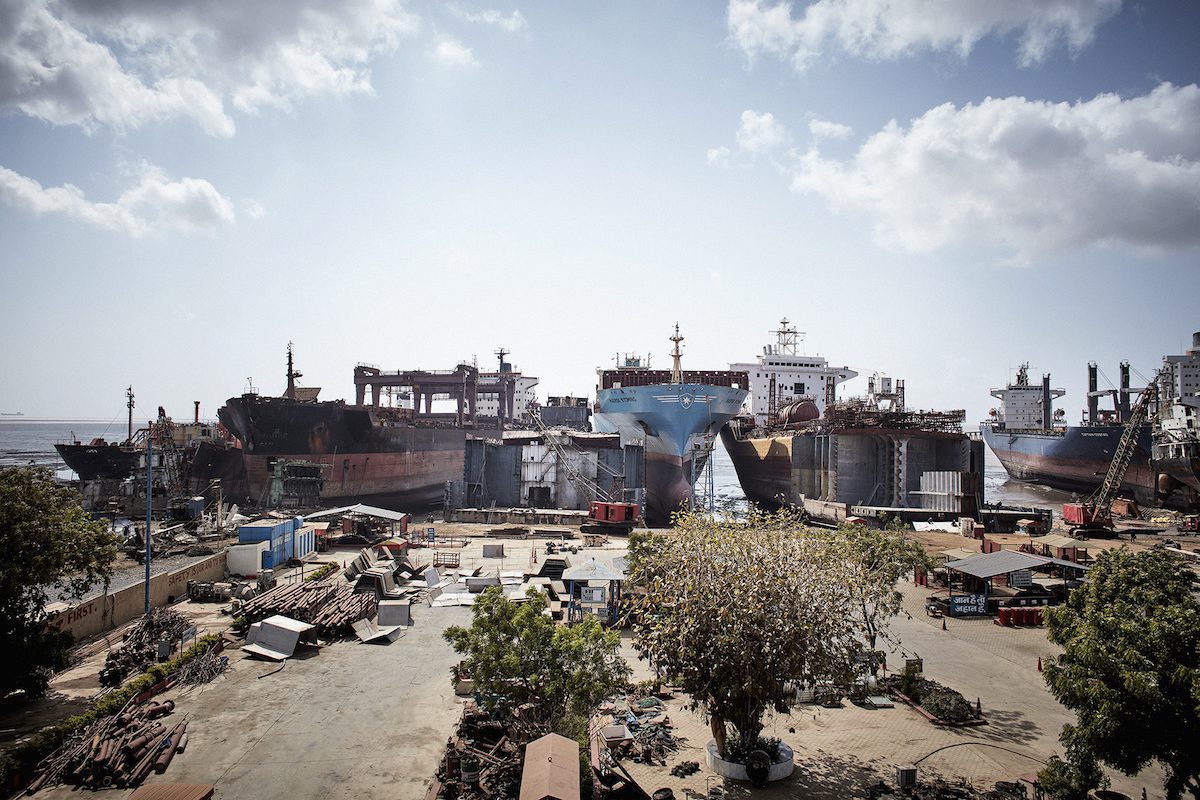Crowley LNG ISO tanks for its Caribbean group that will be used to supply, transport and distribute U.S.-sourced liquefied natural gas (LNG) to bunker fueling facilities. Image via Crowley
By Ryan Hesketh and Jack Wittels (Bloomberg) — Shipping is the backbone of the global economy, responsible for about 90% of world trade. But it also accounts for almost 3% (and rising) of man-made carbon dioxide emissions. The industry’s regulator set a series of emission-cutting targets back in 2018 aimed at driving a transition away from high-polluting fossil fuels. If the more ambitious goals are to be hit, the world’s ships will need to start burning new, clean fuel by 2030. The question is, which one?
1. What’s the bio-bunker options for ships after 2030?
Ships burn about 5 million barrels of fossil fuel every day, pumping a constant stream of CO2 and other chemical nasties into the atmosphere. Yet figuring out the fuel of the future isn’t just about emissions. It’s got to have enough power to propel gigantic tankers around the globe, be storable and transportable, and, of course, not too costly. Here’s a list of the front-runners:
- Ammonia
- Pros: Doesn’t produce any C02 emissions when made cleanly, which can be done by combining so-called green hydrogen with nitrogen from the air
- Cons: Much less energy dense than traditional fuel oils and so would need about three times as much space to contain the same amount of energy, a problem for ship designers; toxic for humans and aquatic life
- Hydrogen
- Pros: Is potent enough to send rockets into space and can be produced without CO2 emissions; can be used in a ship’s internal combustion engine, or in a fuel cell
- Cons: Less energy dense than ammonia and needs to be stored at either -253 degrees Celsius (-423 Fahrenheit) or under high pressure, so another major headache for shipbuilders; it’s also potentially explosive
- Liquefied Natural Gas, or LNG
- Pros: Well-known, readily available, lower CO2-emitting alternative to oil-based fuels and some ships already use
- Cons: Still a fossil fuel so it’s not carbon neutral, although bio and synthetic LNGs do exist. Also needs costly infrastructure and causes methane emissions
- Biofuels
- Pros: Made from the likes of vegetable oil and compatible with several commercial marine engines and bunkering infrastructure
- Cons: More expensive than fossil fuels and a major increase in production would be needed
- Methanol
- Pros: Liquid at ambient temperature so it can be stored in regular, non-pressurized tanks; can be made cleanly and is in use in some ships
- Cons: Less energy dense than oil-based fuels and the clean version is much more expensive
- Nuclear
- Pros: Zero emissions, extremely power dense and is already used by some ships
- Cons: Fail-safe mechanisms are now built into reactor designs, according to ship classification society Lloyd’s Register, but would you want to spend weeks on a nuclear-powered ship?
2. When are ships going to start making the switch?
Projects are underway. Mediterranean Shipping Co. has started using biofuels in Rotterdam, Norway has a small fleet of electrified passenger ferries and Finnish company Wartsila has begun testing ammonia. But there’s a long way to go. LNG, already well known in the shipping industry, was expected only to meet less than 1% of marine fuel demand this year. The UN’s International Maritime Organization, international shipping’s regulator, wants the industry to be carbon neutral by 2100. A.P. Moller-Maersk A/S, the world’s largest container line, has said it wants to have net zero emissions from its operations by 2050.
3. How will shipping get to net zero emissions?
The IMO has targeted a 50% reduction in greenhouse gas emissions from 2008 levels by 2050. Since there’ll be many more ships by then, that really means an 85% reduction per ship. Zero-emission vessels will need to start hitting the water by 2030, according to the Getting to Zero Coalition. A more immediate efficiency-improving target is to cut C02 pollution per transport work (a measure of distance covered multiplied by cargo) by 40% before 2030. Talks focused on greenhouse gas reduction and energy efficiency in shipping were delayed by the global pandemic.
4. How much will it cost and who’s paying?
About $1 trillion to $1.4 trillion of investment will be needed between 2030 and 2050, according to University Maritime Advisory Services, of which almost 90% will be on land. The split highlights the chicken-and-egg problem facing the transition: Shippers are happy to build vessels provided they can guarantee the fuels will be available, but energy companies don’t want to provide fuels unless there’s a market ready for them. In 2019, banks set up the Poseidon Principles as a framework for financing shipping, requiring investors to maintain their lending books in a way that matches goals in the Paris climate agreement. Shipping is also looking to create its own $5 billion climate research fund, financed by a mandatory $2/ton tax on marine fuel over a 10-year period.
5. What about electricity, wind and solar?
Electricity won’t work for deepsea shipping. The batteries needed to power giant tankers for weeks on end would have to be enormous. And if you shrunk the batteries and relied on wind and/or solar to recharge them along the way, you’d run into a problem mariners have faced since time immemorial: the weather doesn’t always do what you expect. It’s not to say there won’t be some wind or solar usage, but only enough to power subsidiary systems, leaving the main engine with the sole task of getting the craft from A to B.
The Biobunker Reference Shelf

 Join The Club
Join The Club











